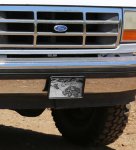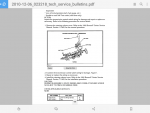Yo Gary,
Will be back later or Tuesday with more info.
For now try a Self Test for Diagnostic Trouble Codes (DTC)s by my pal, BroncoJoe19
@
http://broncozone.com/topic/14269-code-reader/?pid=74587&mode=threaded
The engine temperature must be greater than 50° F for the Key On Engine Off (KOEO) Self-Test and greater than 180° F for the Key On Engine Running (KOER) Self-Test.
Run it around to heat the engine up and shift thru all gears including Reverse.
Make sure A/C is off and transmission is in Park (automatic); or in Neutral for a Manual & release clutch.
Then turn off engine, all accessories/lights (close driver's door) , etc.
A helper can assist you by counting the codes. Some use their smart phones to record them.
BEWARE OF FAN, BELTS, PULLEYS, HOT HOSES, IGNITION HIGH TENSION WIRES, AND ENGINE COMPONENTS
Do KOEO test First
Post Code(s) here according to: KOEO & KOER
Or ask local mom and dad parts stores if they will test it for you.
Or purchase a coder reader such as Equus 3145 Innova OBD I Code Reader for Ford EEC IV Engines at Walmart &€ most parts stores.
A vacuum leak is a typical surge perpetrator.
See my vacuum leak test in post #20 @
http://broncozone.com/topic/23994-90-58l-getting-continuous-code-33-and-running-code-44/?p=125535
One way to do a quick check is to grab a vacuum gauge. Bring the engine to normal operating temperature. Connect gauge to the intake manifold tee. BEWARE OF FAN, BELT, PULLEYS & HIT ENGINE.
The vacuum gauge should read between 15 and 22 in-Hg depending upon the engine condition and the altitude at which the test is performed. SUBTRACT ONE INCH FROM THE SPECIFIED READING FOR EVERY 1,000 FEET OF ELEVATION ABOVE SEA LEVEL.
The reading should be quite steady. .
When engine is rapidly accelerated (dotted needle), needle will drop to a low (not to zero) reading. When throttle is suddenly released, the needle will snap back up to a higher than normal figure.
When vacuum leaks are indicated, search out and correct the condition. Excess air leaking into the system will upset the fuel mixture and cause conditions such as rough idle, missing on acceleration, or burned valves. If the leak exists in an accessory unit, such as the power brake, the unit will not function correctly. Or Air Conditioning when in MAX mode may switch to Defrost.
Will work on the gauges later. But here is a wiring diagram,
http://www.revbase.com/BBBMotor/Wd/DownloadPdf?id=8639
Check fuse #17 first.
One perp for a blown #17 fuse is Fuse 17 Blown, Short Circuit in TSB 92-22-5 for 92 Bronco & all Light Trucks. The transmission control switch wiring may be misrouted causing a short in the steering column and a blown # 17 fuse. The following symptoms may be associated with this concern; Early shifts, Loss of power, Poor acceleration, 3-4 shift cycling, Transmission control light cycling ON/OFF or inoperative, Transmission control switch inoperative, Rear Anti-Lock Brake System (RABS) electronics (dash lights inoperative, ☆Loss of instrumentation (tach, fuel gauge, etc.),☆ Unable to read Self-Test codes (solid tone only with a code scanner).
Inspect the transmission control switch wiring for damage and repair or replace as necessary. Refer to the following procedure for service details.
1. Remove the steering column cover. Refer to the 1992 Bronco/F-Series Service Manual, Section 11-04B, for the removal procedure.
2. Examine the transmission control switch wiring for damage, Figure 1. (I don't have this Figure)
3. Repair or replace the wiring as necessary.
4. Install the steering column cover. Refer to the 1992 Bronco/F-Series Service Manual, Section 11-04B, for the installation procedure.
CAUTION:
DURING REASSEMBLY, ROUTE WIRING AWAY FROM ATTACHING ***** SO AS NOT TO PINCH OR DAMAGE WIRE.
OTHER APPLICABLE ARTICLES: NONE
WARRANTY STATUS:
Eligible Under Bumper To Bumper Warranty Coverage
OPERATION DESCRIPTION TIME
922205A Repair Wiring 0.6 Hrs.
DEALER CODING
BASIC PART NO. CONDITION CODE
15A808 X1
OASIS CODES:
201200, 203200, 204000, 206000, 301000, 501000, 503300, 504000, 614000, 614600
The transmission control switch is at end of shifter stalk.
.
GL!



